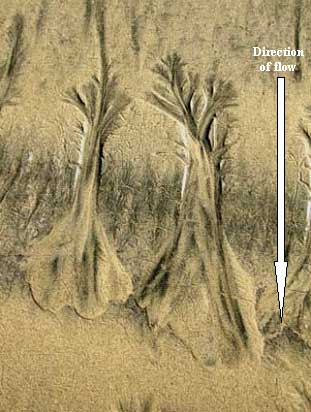Just south of Oceanside, perennial groundwater seeps at the base of the cliff send water spreading over beach toward the ocean. Walking along this section of beach, you may notice some unusual groundwater-flow-patterns, channeled sand patterns that result from this flow of the fresh water coming out of the sand.
I was long curious about the mechanics of these flow patterns. Then I read an article in the February 2009 issue of Scientific American by Peter B. Kelemen from Columbia University’s Lamont-Doherty Earth Observatory on how these patterns form. According to Kelemen, as groundwater flows onto the beach toward low spots, it picks up sand grains and carries them along while eroding increasingly deeper channels that, though initially random, converge into a reverse dendritic pattern with water and sand flowing from the branches toward the trunk. The flow finally organizes into a single deep trough. This erosion pattern conserves energy because in the single deep channel that eventually forms, there is a minimum of friction between the flowing water and the sand in the bottom of the trough.
The sand-laden water flows through the single channel for a short distance. Then the sand grains begin to drop out, creating small barriers that redirect the water into diverging channels. These barriers may dam some of the water for a short time, but it eventually overflows the dams, carving new pathways. Finally, all of the sand settles out to form an array of small alluvial fans.

